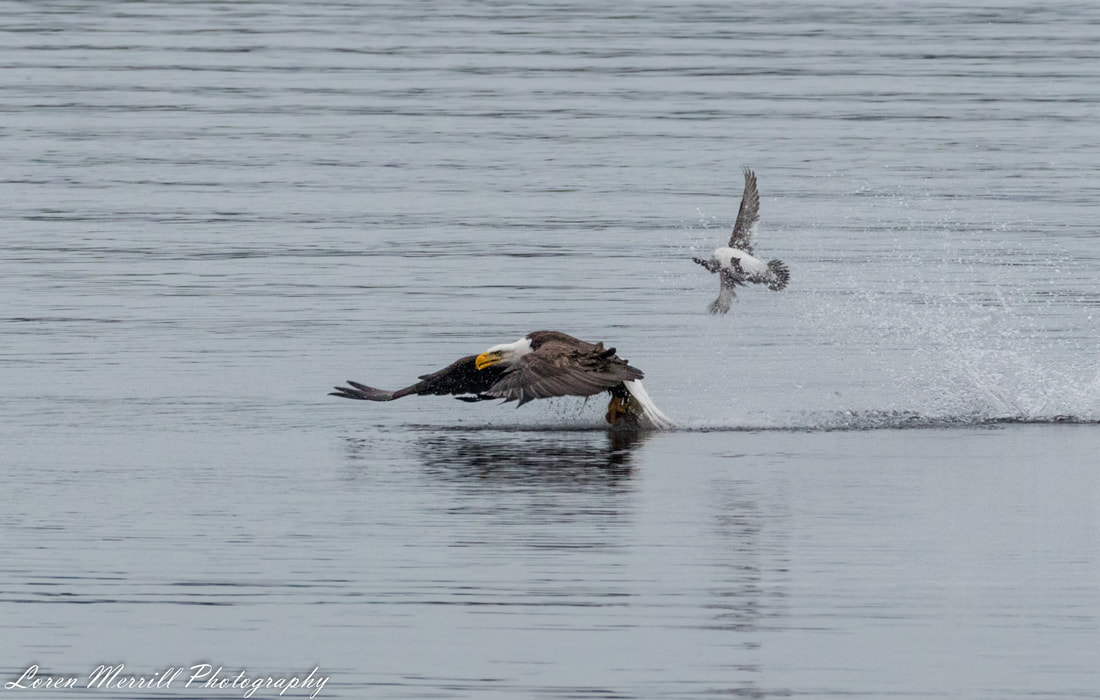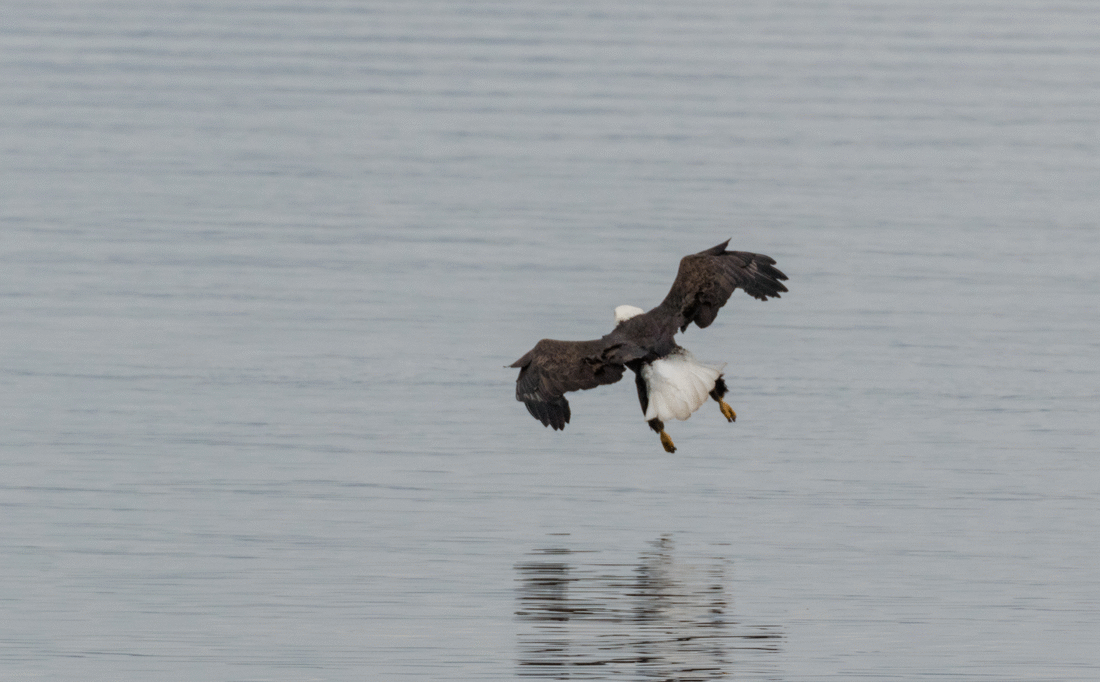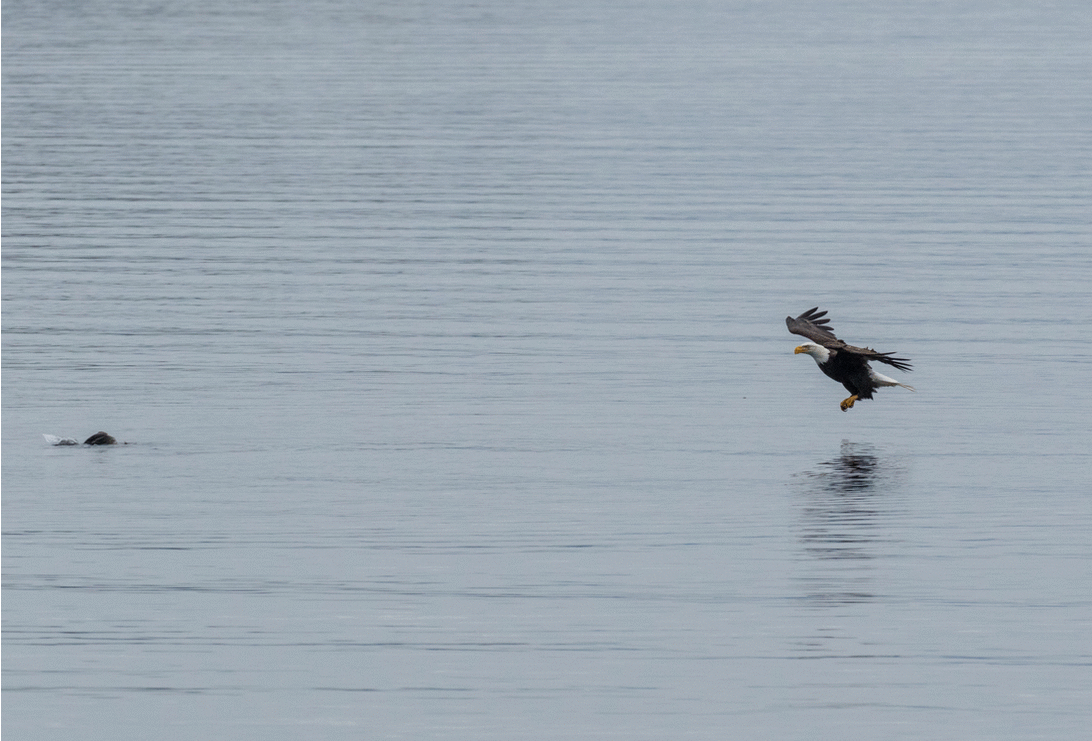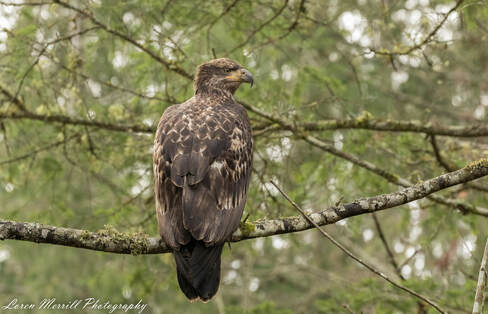 An immature Bald Eagle (likely a first year bird) perches on a branch near Nanaimo, BC. An immature Bald Eagle (likely a first year bird) perches on a branch near Nanaimo, BC. The call of a bald eagle is not well-matched to the predator’s persona; it is a high-pitched, whinnied laugh that seems better suited to a gull or shorebird. So when I heard one calling outside the door last week, I was not immediately roused to investigate. We have lots of eagles in the area, and while I always love watching them, an eagle call does not always warrant further inspection. But in this case, the calling was incessant, and quite loud, so I got up to take a look out the window and quickly realized there was something extraordinary happening. Two adult bald eagles, easily distinguished from immature birds (below) by their pure white heads and tails, were flying around, calling repeatedly. I watched as one bird flew out from the shore with powerful flaps, and began dropping close to the water surface. As it did so, its talons extended downwards, and it made a grab at something in the water (see below). Behind the lens of my camera I attempted to capture the events unfolding out on the water. 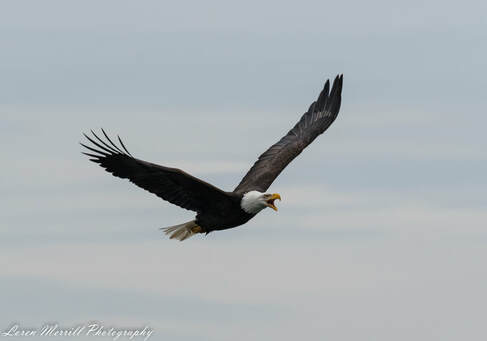 A Bald Eagle flies towards the shore after a failed hunting attempt, expressing its frustration loudly. Ladysmith Harbor, BC. A Bald Eagle flies towards the shore after a failed hunting attempt, expressing its frustration loudly. Ladysmith Harbor, BC. I could not tell what the eagle had swiped at, but the eagle quickly looped around and headed back towards the spot in the water it had struck at moments before, calling loudly as it flew. It made another swipe at the water, and I could see a small, dark shape disappear in the water as the eagle approached. I still had no idea what it was, but thought perhaps it was one of the river otters that had captured a large fish the eagle was trying to steal. After this second attempt, the eagle headed directly towards me, again vocalizing loudly. I tried to see if the bird had anything in its talons, and it appeared as though it did, but I could not be sure. As the bird flew over my head into the trees above our house, I turned back to the water to see the second eagle flying to the same location the first eagle had targeted. Again I could make out some small dark shape that vanished as the eagle swooped low, striking at the water. I took a quick look at the images on the camera and was finally able to get an ID on the target: a female common goldeneye. Common goldeneyes (so named for their bright yellow irises) are diving ducks, and therefore are adept at disappearing beneath the surface of the water. Like the buffleheads highlighted in the previous post, they dive to the bottom of the ocean to search for mollusks and crabs to consume, which they swallow whole, and crush with a powerful gizzard. But this female goldeneye was diving with more at stake than a meal, and was soon going to be facing a pack-like hunting strategy. The second eagle was making passes at the duck, which would attempt to dive before the eagle approached too closely. Eagles make a living finding prey under the surface of the water and timing their attack to grab the prey at, or just below, the surface. I captured a few sequences of the second eagle swooping and striking at the water, but I could not tell in real time what was happening. The lone (second) eagle was joined by another (third) adult eagle, and soon a fourth came out, and these three birds began a series of concerted attacks on the ducks. The original bird was still perched in the trees behind me, but keeping an eye on events over the water. The three hunting birds’ strategy unfolded as follows: one would pass low, forcing the duck under water, and then the second and third birds would time their strikes in an attempt to get the duck when it surfaced. This pack-like hunting strategy is not something I had ever seen or heard about in bald eagles, and I watched in stunned fascination. Harris’s hawks in the US southwest are known as pack hunters, and are thought to be the only cooperative pack-hunting hawks (falcons will work in tandem to bring down prey), but the eagles’ behavior seemed cooperative to me. Perhaps it was simply opportunistic hunting that appeared to be cooperative. Regardless, the eagles were at a clear advantage- the goldeneye could not take off or it would be an easy target- but the goldeneye varied how long it was underwater, and where it would surface. This seemed to work, and the eagles’ repeated strikes never found purchase. Or so I thought. I began wondering if the duck was injured, and how long she could outmaneuver the eagle pack, and when the original bird joined the hunt, I thought she was done for. But slowly, the eagles’ focus seemed to shift away from the duck. The eagles began partitioning the airspace into two areas; one pair began looping around in the area over the duck, still making low passes over the water, but no longer striking the water. The other pair headed to the east, and began looping around each other as well, making low, swooping passes over the water in a loose figure-eight formation. This was not the first time I had seen this behavior from the eagles here. The prior week, my attention had been drawn to a pair of eagles out over the water, calling and performing these same swooping, figure-eight flights around one another that would take them close to the water’s surface, and then up again into the air. My assumption is that this is a mating display of sorts, and that it serves as a form of pair-bonding, similar to the head-bobbing, bill-tapping dance that albatrosses engage in, but on a much grander stage. Two of the eagles broke off their flight display, and headed towards a floating dock. The birds alighted facing each other, and began a series of head-up displays, calling briefly before quieting down. The other two birds continued their aerial exhibition for a few minutes more before retreating to the shoreline and disappearing into the trees. I stepped back inside and began looking through some of the images I had taken. When I got to one of the second eagle’s early passes at the goldeneye, I realized I had captured an incredible near-miss sequence. As the images and GIF show, the duck makes a late dive attempt, which allows the eagle to grab it from just under the surface. The water and weight of the duck create too much resistance for the eagle, and the duck slips out of its talons. But the eagle’s momentum lifts the duck out of the water, flipping it end over end through the air. Amazingly, the presumably dazed duck is able to continue evading the eagles after this encounter, and once the eagles’ attentions turn towards each other, she is able to paddle off to recover. One lucky duck indeed. 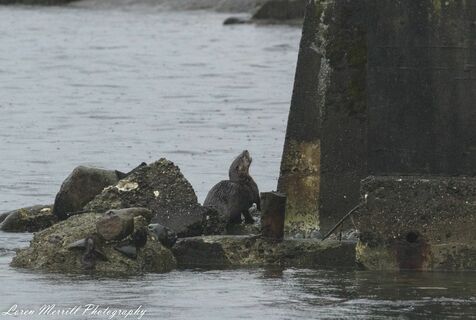 The aftermath: a river otter glares at the sky after a Bald Eagle appeared from nowhere to steal the otter's crab dinner. Ladysmith Harbor, BC. The aftermath: a river otter glares at the sky after a Bald Eagle appeared from nowhere to steal the otter's crab dinner. Ladysmith Harbor, BC. I mention at the start of this piece that the call of the eagle does not seem to befit a predator of their stature. The reality, however, is that bald eagles are extremely opportunistic. In addition to hunting for a range of prey items, they will consume carrion, forage at dumps for scraps (and associated rats and mice), and happily kleptoparasitize food from others. Their favorite targets here are the river otters. In our first week at the house, I was working at the table and out of the corner of my eye, noticed a large shape glide quickly past the window. I hopped up to see a bald eagle swooping down through the light rain, towards the rock outcropping at the stream mouth just to our east. The eagle was approaching the rocks from a very low angle, hidden from view somewhat by the seawall. When the large raptor got to the rocks, it banked sharply, reached out its talons and grabbed a large crab from one of the otters that had, until that moment, been enjoying its meal in peace. The startled otter looked up and around, and then quickly went back to eating in an attempt to stuff all the remaining scraps of food into its mouth before anyone else could come steal them. It repeatedly glanced skyward, as though expecting another raid from above at any moment. In the subsequent weeks, I have watched eagles swoop on the otters a few other times, most recently this morning. Today, however, there were three otters eating a large crab close together, and the eagle’s attempt did not yield any food. The eagle retreated to the top of a large Douglas fir to watch, and wait for another opportunity at an easy meal. Brief epilogue: These impressive raptors experienced dramatic population declines in the 1900s due to DDT use, hunting, and pollution, and were placed on the Endangered Species Act (ESA) in 1967. It is estimated that their numbers declined from perhaps half a million birds in the lower 48 in the 1800s, to 412 nesting pairs in the 1950s. Today, they are thriving in many areas of North America, due in large part to the ESA and the banning of DDT. The eagle’s delisting in the 90s was seen as a major success story for the ESA, and now people all over North America have the opportunity to watch these birds in action. In the next post, I cover an antagonistic interaction between a harlequin duck and a common merganser that is one of the funniest, most spiteful, and human episodes I have seen in birds.
0 Comments
Leave a Reply. |
About the author:Loren grew up in the wilds of Boston, Massachusetts, and honed his natural history skills in the urban backyard. He attended Cornell University for his undergraduate degree in Natural Resources, and received his PhD in Ecology from the University of California, Santa Barbara. He has traveled extensively, and in the past few years has developed an affliction for wildlife photography. Archives:
|
